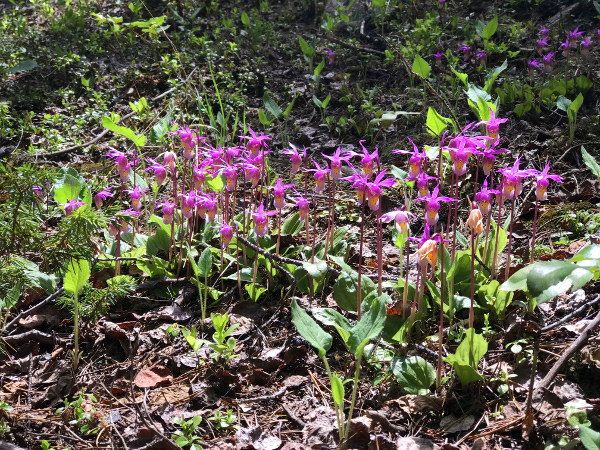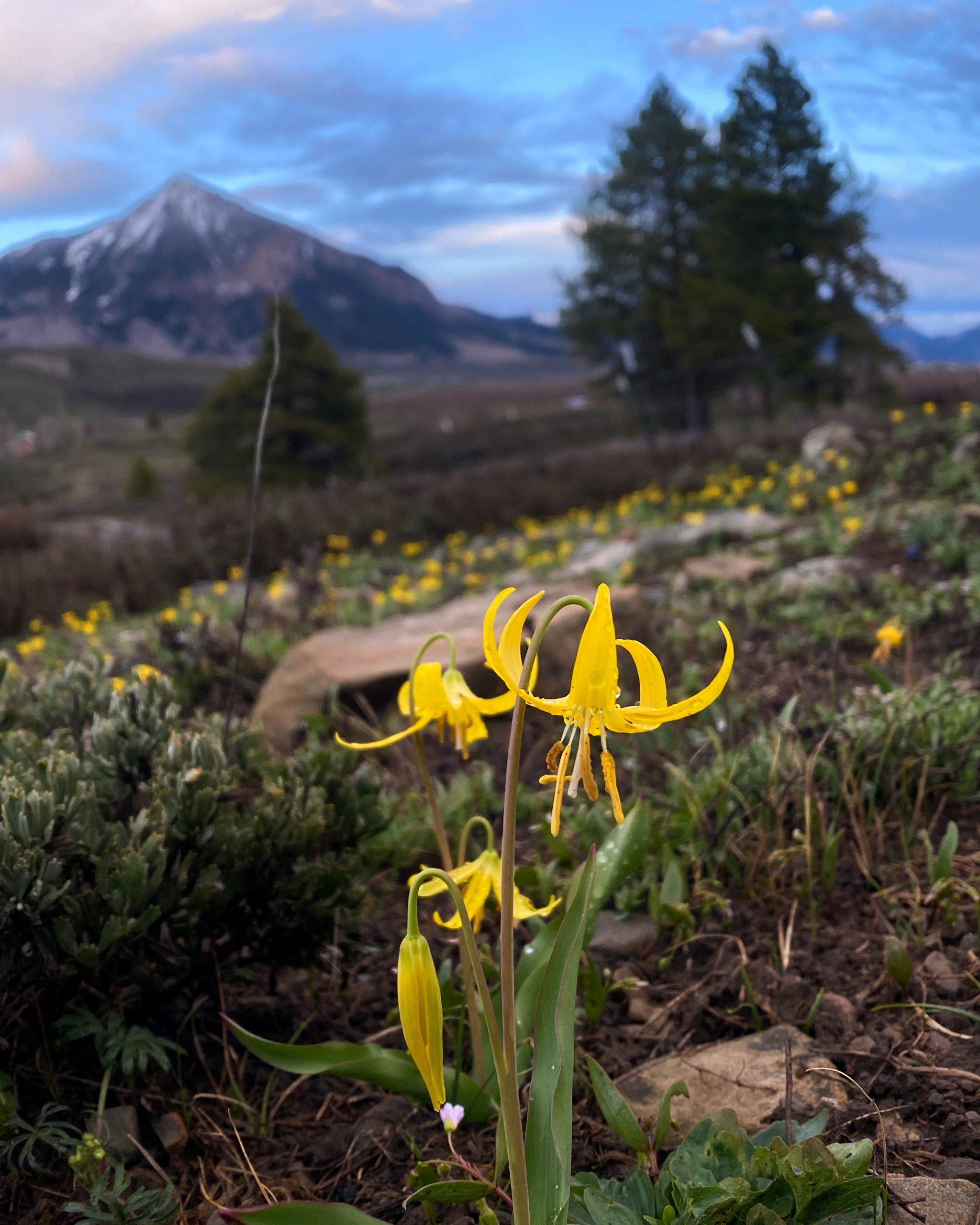Early-Season Colorado Wildflower Guide
Colorful wildflowers bloom all spring and summer in Crested Butte, the Wildflower Capital of Colorado. Early spring blooms begin in late May or early June. They usually start in Gunnison because the snow melts out sooner in the south valley. Peak wildflower season, when the flowers are at their densest, is July and August. If you’re wondering what some of the most common early-season blooms are, we’ve put together this handy early-season Colorado wildflower guide for your adventures.
Wildflower etiquette
Though the wildflowers are beautiful and eye-catching, they belong outside. Please follow proper backcountry etiquette to avoid a ticket or fine. It can be tempting to pick the flowers to bring home in a bouquet. Picking wildflowers is not only illegal but can damage fragile environments. Leaving the trail to get closer and pick them can also harm the ecosystem. The best way to appreciate the wildflowers is by photographing them and leaving them so they can continue to bloom for many summers to come. Make the most of your trip to Colorado by reviewing our resources for Colorado travelers guide.
Where are the best places to see wildflowers in Crested Butte and Gunnison?
The Gunnison Valley is nestled among millions of acres of protected public lands. These protected lands provide ample space for wildflowers to bloom uninhibited. Some places to see wildflowers in Crested Butte include Brush Creek, Snodgrass and the Crested Butte town trails. Hartman Rocks is one of the best places to see wildflowers in Gunnison.
When is wildflower season in Crested Butte and Gunnison?
The exact times the wildflowers bloom depends on winter snowfall and when the snow melts. Early-season wildflowers usually start blooming in June. The first wildflowers in the Gunnison Valley tend to bloom at Hartman Rocks and Signal Peak in Gunnison. The wildflowers usually peak in July and are gone by the end of August.
Silvery Lupine (Lupinus argenteus)

Silvery Lupine is one of the most common flowers in the Gunnison Valley and this wildflower guide. There is even a trail named Lupine between Crested Butte and Mt. Crested Butte. This trail is bursting with these purple blooms. Lupines can be silvery purple, magenta or dark purple. These flowers are tall with showy spikes of blooms. The blooms are dense with elongated clusters of pea-shaped flowers. Look for lupine down in Gunnison starting in late May. These flowers can be found further up the valley starting in June. They love sunshine, so any open areas will house tons of the flowers. Brush Creek is an excellent place to see lupines.
Calypso Orchid (Calypso bulbosa)

The Calypso Orchid is one of the hardest early-season wildflowers to spot. They only grow in a very specific environment. They grow in mid-elevation evergreen forests that are cool, moist and shaded. Two of the best places to search for them are Cement Creek or Taylor Canyon near small creeks. They are sometimes found growing in clumps, but it’s more common to find just one or two. Calypso orchids are also known as “fairy slippers.” These blooms are a single, nodding showy flower that are about 2-3 cm across. The most common color of this flower in the Gunnison Valley is purple/magenta. The flowers have a single basal leaf that is oval and green. This flower is rare and sensitive to habitat disturbance.
Larkspur (Delphinium nuttallianum)

Larkspur is common throughout the Gunnison Valley. The plant produces blue and purple petals and is in the buttercup family. The blossoms are tall, spiked and irregularly shaped. Each flower has five petal-like sepals. One of these forms a long, backward-pointing spur. The flower also has four true petals. The leaves are at the base of the plant and are deeply lobed and feathery in appearance. They grow in open meadows, forest clearings and grasslands. They usually stop blooming in August. This flowers scientific name comes from the Latin delphinium, which is a word for dolphin and refers to the shape of the nectary of the flower. Larkspur provides important pollinator support for bees and butterflies.
Indian Paintbrush (Castilleja chromosa)

Indian paintbrush can be found almost everywhere in the Gunnison Valley. This is one of the first bloom to pop up in May down at Hartman Rocks. Check out this spring wildflower guide for flowers that can be found at Hartman Rocks. Paintbrush adds a splash of red to the granite and sage landscape. It begins to grow in the north valley and the alpine later in the summer. It can still be seen as late as August in some places. The petals are colored bracts that grow in clusters rather than true petals. The bracts grow around the small and inconspicuous true flowers. They grow in well-drained soils and like full sun. They can grow in areas with poor, rocky or sandy soils. These flowers grow in groups, so if you find one you’ll likely find more.
Glacier Lily (Erythronium grandiflorum)

Glacier lilies have an elegant and ephemeral look. They are bright yellow. The flowers are nodding and bell-shaped with six tepals. A single flower grows on top of a slender stalk. Two lance-shaped, bright green basal leaves grow from the base of the plant. They can grow 4-16 inches tall. While they are quite common, they are usually gone by the end June. They are one of the first flowers to bloom and can even be seen growing next to patches of snow. Spotting glacier lilies usually means spring is here. They are also known as the yellow avalanche lily. They can be seen at the top of Oh-Be-Joyful Creek and on Kebler Pass. Their flowering period corresponds to the runoff season and the creeks and rivers are often very high.
Arrowleaf Balsamroot (Balsamorhiza sagittata)

The first of the big yellow sunflowers to appear in the valley, the arrowleaf balsamroot is often confused with mule’s ears sunflower. While there bloom seasons do overlap towards the tail end of the Balsamroot’s bloom, the best way to tell them apart is location and leaf shape. Just like the name suggests, the arrowleaf balsamroot has an arrowhead shaped leaf that tends to be shorter than the mule’s ears sunflower’s. Also, the balsamroot prefers a drier, lower elevation sage habitat. You’re most likely to find these flowers in Jack’s Cabin or Cement Creek than up near Gothic or Irwin. Learn about other sunflowers here in this peak season wildflower guide.
Plan a Colorado trip
The best times of year to see these wildflowers are late spring or early summer. Start planning a Colorado spring or summer trip! Plan hikes and mountain bike rides to some of the places in this wildflower guide. Book flights for getting here and reserve lodging early for the best rate.
